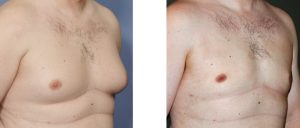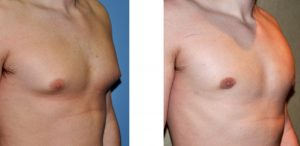The condition known as ‘Man Boobs’ is getting a lot of attention in the media recently. Known medically as gynecomastia, any enlargement or expansion of an otherwise flat chest in a man is being given this unflattering name. The man boob problem is a wide spectrum of chest wall deformities that are just as variable in appearance as breasts are in women. While being overweight is certainly associated with excess chest tissue, I have seen many patients in my Indianapolis plastic surgery practice that have ‘man boobs’ and are not overweight or significantly out of shape.
Numerous websites and e-articles tout that gynecomastia can be treated with weight loss or pectoral or chest exercises. While this approach may have some benefit in the overweight male, it will not get rid off excess breast tissue in an otherwise weight-appropriate body frame. While diet and exercise can reduce overall body fat, it is much more challenging to try and achieve spot reduction on the chest wall. The type of fat that is on the chest is of a different consistency than that of the abdomen, for example. It is more of a fibrofatty tissue particularly around the nipple-areolar complex. Such tissue type is more resistant to typical metabolic fat reduction approaches.
Gynecomastia in the younger male can be classified into four types. Types 1 and 2 are when the breast tissue enlargement is limited to just underneath the nipple (1) or fans out to within four and 5 cms from the nipple. (2) Types 3 and 4 are much larger and become more mound-like as is characteristic of a female breast. An important determinant of the proper treatment approach is how this breast tissue feels. Is it soft and squishy or does it feel like a harder lump or mass?


Smaller amounts of gynecomastia in the young male can not usually be reduced with any form of exercise or dieting, particularly if one is not overweight. Laser liposuction and scar-friendly excision can solve these gynecomastias with one hour of surgery. Recovery is fairly quick with the need to only wear a narrow chest wrap for a week or two. One can resume running in two weeks and weight lifting in three weeks.
Barry L. Eppley, M.D., D.M.D.
Indianapolis, Indiana


